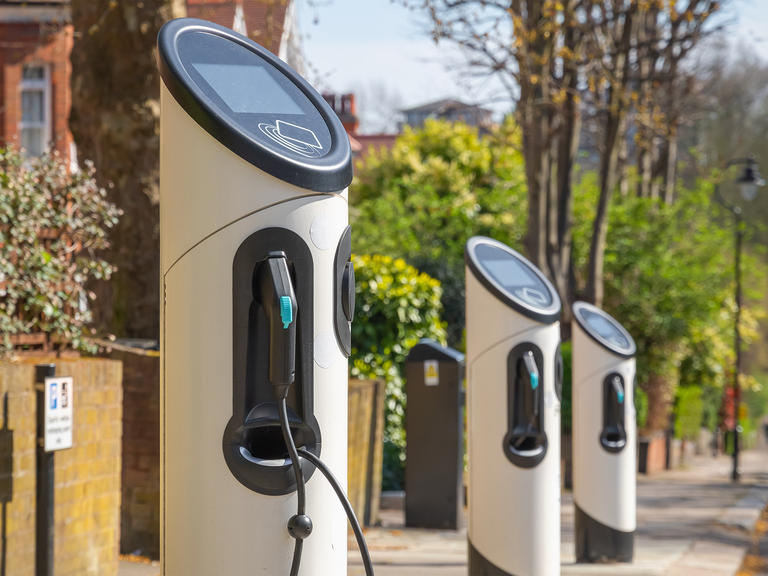EV does it: SBD Automotive on what the EV Index tells us about charging

Robert Fisher, lead analyst for SBD Automotive, talks to HERE360 about the findings of the EV Index, a joint project between HERE and SBD Automotive.
A comprehensive index of all 50 US states, Washington DC, and 30 European countries shows huge disparities between regions for electric vehicle (EV) charging.
The EV Index, a joint project between HERE and SBD Automotive, reveals who the leaders and laggards are. The interactive index shows the developing state of EV demand and infrastructure readiness across the two regions.
It uses various critical metrics, including how quickly you can charge and how far you must drive to find a charger in each location.
Robert Fisher, EV Principal at SBD Automotive which is a global team of researchers and analysts supporting the automotive industry, spoke to HERE360 about the findings. Crucially, being able to compare several different criteria at once shows that even in those parts of the world considered to be favorable for EV drivers, the story is not so simple.
“There is a disparity between the mature EV markets in Europe and the US and the ones that actually have enough EV charge points," he said. “A good example is California. People in the US think of California as being the leading market for EVs, but they are not necessarily leading in terms of access to charging or in overall enablement of electric mobility."
There are 4.9 charge points per EV in California, but the average charger power is very low, because their charging network was built relatively early, when high-speed charging was not yet commonplace.
“What that means is that the average person traveling through California will not have much difficulty finding a charge point, but on average, it's going to be a very slow recharge," Fisher explained.
Similarly, in the Netherlands, the average charge point power is the lowest in the whole of Europe, which means EV drivers might be able to find a charge point easily but it will likely take them “hours to recharge."
New legislation sets out requirements for charge points in Europe that include a stipulation about how fast they must be. In the EU, charge points will have to offer at least 150kW of power from 2025. They must be installed every 60km along the EU's Trans-European Transport Network (TEN-T) and be available without a subscription. Along with the US' ambitious infrastructure plans, this approach should make a difference to EV owners, Fisher said.
And even before that becomes a reality, he said the Index shows substantial journeys, as well as short, local drives, are now feasible in most places.
“We have finally gotten to the point where long trips and mobility across the continent or across the US are possible without significantly impacting someone's plans. Even just three or four years ago, a 10-hour journey today might have taken twice as long due to much slower charging speeds," he added.
Nevertheless, range anxiety remains a barrier to uptake.
The map visualization above show the distribution of electric vehicles per charging point in each state, based on data from the HERE EV Charge Points API and the U.S. Department of Energy. The charging infrastructure data is pulled from December 31st of 2020, 2021 and 2022.
Perception vs reality
In addition to the EV Index, SBD Automotive has carried out research into whether fears about range dissipate with ownership experience.
A recent survey they conducted showed that range is the top concern for consumers considering owning an EV. It is also the main worry for EV owners — and this is common across the three markets of Europe, US and China. This concern is followed by the number of charge points available, speed and cost of charging.
“Range anxiety is something that keeps people awake at night when they're considering a new vehicle. And it also keeps them awake at night when they finally do purchase an EV, but usually for just a short period of time, as they're getting used to the mechanics of how to get from point A to point B," Fisher said.
When compared to results from the same survey in 2020, SBD's analysts found that fears about not having enough charge points in the US have decreased significantly, by about 25%.
US legislation encouraging new charge point infrastructure is likely the reason, Fisher said, even though not all of these have yet been built. However, building more charge points is only part of the solution, as the EV Index shows.
“In most markets, as the number of EVs increases, the number of EVs per charge point increases," Fisher explained.
“The ratio of vehicles to chargers should increase as the market matures while ensuring certain limits are respected. We have to start with a minimum geographic density to ensure availability to everyone, and next, work on improving the power at those charge points.
“We also need to work on improving the profitability of the charge point operators. Because at the beginning, all those operators are running from grants, loans and other subsidies that are not sustainable. Networks that have been around for 10 to 15 years are only now starting to become profitable."
When it comes to positive reasons for owning an EV, lower running costs is the second most common motivator, with environmental impact still the first, the research shows. Maintenance costs for EVs can be lower than for internal combustion engine (ICE) vehicles, and the higher cost of fuel is a factor.
And it seems that those who do make the leap are mostly happy with their decision.
“Despite all the negative press, our survey showed that EV drivers are generally satisfied with their charging networks in the US, Europe and China," Fisher said, referring to the SBD Automotive research.
“Fewer than 20% said they were dissatisfied with factors including the number of charging stations, reliability, ease of use and ease of paying."
The most important thing for the EV industry is not only that government incentives continue, he said, but that the authorities are consistent and develop long-term plans. That way, the industry can plan ahead for the vehicles and infrastructure needed for five or even 10 years' time.

Taking action
How should automakers respond to these challenges? Fisher has two suggestions.
“One of them is dispelling some of the rumors and myths around EVs specifically when it comes to range and charging," he said. “And the second one is to ease a consumer's transition by supporting their transition to electric mobility."
That could take the form of a trial run on an EV. An example he gave is the Volkswagen EV check app. It tracks a customer's typical movements and driving behavior and tells them how they would have to adapt their routine to accommodate charging an EV, whether an EV is right for them and suggests suitable models.
Demystifying the reality of driving an EV can help consumers make the switch, Fisher said, including understanding costs and range.
HERE tests showed that manufacturers typically overestimate a vehicle's range by 20%. Fisher said SBD Automotive tests have shown it can sometimes be even more inaccurate than that, depending on weather, traffic and terrain conditions.
“We've seen vehicles that were claimed to have 300 miles of range that could only manage 150 during specific tests," he said. “But there are many technical strategies and user interface design considerations that can be implemented so that the user understands what that range actually means and the factors that might affect it."
The more information the driver gets about how conditions such as wind or traffic can affect range, the better they will understand how best to control and adapt to it.
Addressing myths about EVs is something the original equipment manufacturers (OEMs) should take seriously too, he said. “They should be out there explaining how simple life with an EV can be," Fisher said.
“EVs are not for everyone — the state of Alaska, as an extreme example, experiences very cold weather, and has few chargers and long roads. But for the majority of users in the majority of regions EVs can make sense.
"Continuous improvements to access to charging, both public and private, will ensure that electrification becomes the norm, not the exception."
Have your say
Sign up for our newsletter
Why sign up:
- Latest offers and discounts
- Tailored content delivered weekly
- Exclusive events
- One click to unsubscribe


